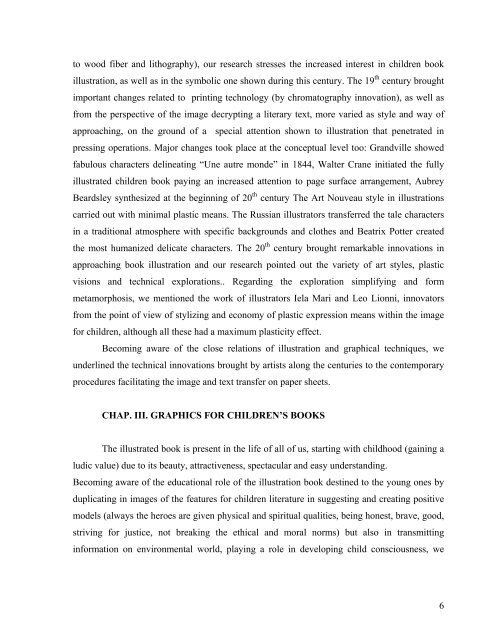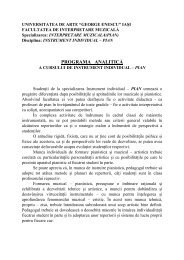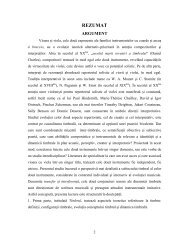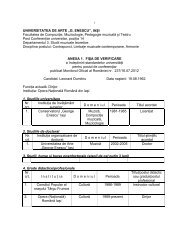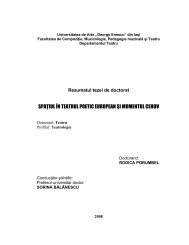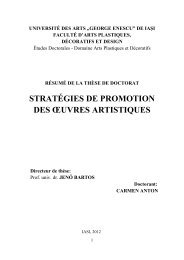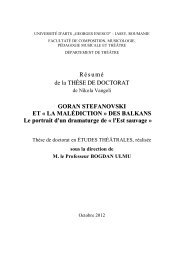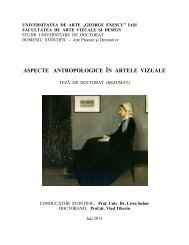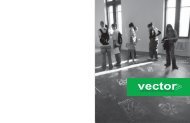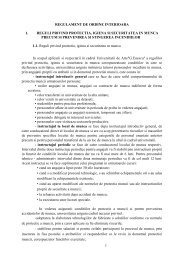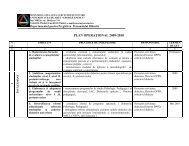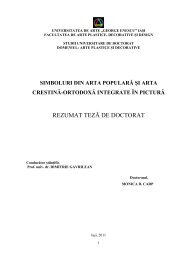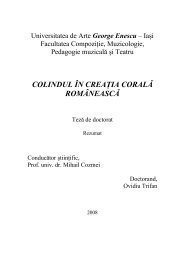Caloian Cezarina - Universitatea de Arte "George Enescu"
Caloian Cezarina - Universitatea de Arte "George Enescu"
Caloian Cezarina - Universitatea de Arte "George Enescu"
You also want an ePaper? Increase the reach of your titles
YUMPU automatically turns print PDFs into web optimized ePapers that Google loves.
to wood fiber and lithography), our research stresses the increased interest in children book<br />
illustration, as well as in the symbolic one shown during this century. The 19 th century brought<br />
important changes related to printing technology (by chromatography innovation), as well as<br />
from the perspective of the image <strong>de</strong>crypting a literary text, more varied as style and way of<br />
approaching, on the ground of a special attention shown to illustration that penetrated in<br />
pressing operations. Major changes took place at the conceptual level too: Grandville showed<br />
fabulous characters <strong>de</strong>lineating “Une autre mon<strong>de</strong>” in 1844, Walter Crane initiated the fully<br />
illustrated children book paying an increased attention to page surface arrangement, Aubrey<br />
Beardsley synthesized at the beginning of 20 th century The Art Nouveau style in illustrations<br />
carried out with minimal plastic means. The Russian illustrators transferred the tale characters<br />
in a traditional atmosphere with specific backgrounds and clothes and Beatrix Potter created<br />
the most humanized <strong>de</strong>licate characters. The 20 th century brought remarkable innovations in<br />
approaching book illustration and our research pointed out the variety of art styles, plastic<br />
visions and technical explorations.. Regarding the exploration simplifying and form<br />
metamorphosis, we mentioned the work of illustrators Iela Mari and Leo Lionni, innovators<br />
from the point of view of stylizing and economy of plastic expression means within the image<br />
for children, although all these had a maximum plasticity effect.<br />
Becoming aware of the close relations of illustration and graphical techniques, we<br />
un<strong>de</strong>rlined the technical innovations brought by artists along the centuries to the contemporary<br />
procedures facilitating the image and text transfer on paper sheets.<br />
CHAP. III. GRAPHICS FOR CHILDREN’S BOOKS<br />
The illustrated book is present in the life of all of us, starting with childhood (gaining a<br />
ludic value) due to its beauty, attractiveness, spectacular and easy un<strong>de</strong>rstanding.<br />
Becoming aware of the educational role of the illustration book <strong>de</strong>stined to the young ones by<br />
duplicating in images of the features for children literature in suggesting and creating positive<br />
mo<strong>de</strong>ls (always the heroes are given physical and spiritual qualities, being honest, brave, good,<br />
striving for justice, not breaking the ethical and moral norms) but also in transmitting<br />
information on environmental world, playing a role in <strong>de</strong>veloping child consciousness, we<br />
6


